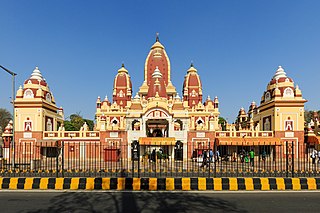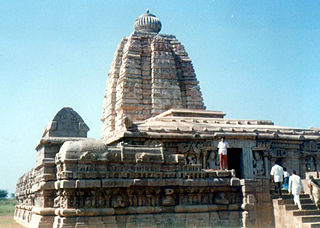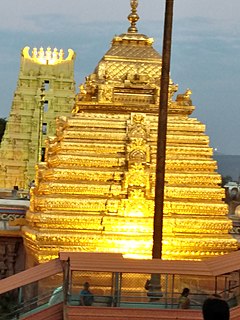Related Research Articles

The Krishna River is a river in the Deccan plateau, and the third-longest river of India, after the Ganges and Godavari, and the fourth-largest in terms of water inflows and river basin area in India, after the Ganges, Indus and Godavari. The river, also called Krishnaveni, it is 1,400 kilometres (870 mi) long and its length in Maharashtra is 282 kilometres. It is a major source of irrigation in the Indian states of Maharashtra, Karnataka, Telangana and Andhra Pradesh.

Coastal Andhra is a region in the state of Andhra Pradesh, India. It was part of Madras State before 1953 and Andhra State from 1953 to 1956. According to the 2011 census, it has an area of 91,915 square kilometres (35,489 sq mi) which is 57.99% of the total state area and a population of 34,193,868 which is 69.20% of Andhra Pradesh state population. This area includes the coastal districts of Andhra Pradesh on the Circar Coast between the Eastern Ghats and the Bay of Bengal, from the northern border with Odisha to Tirupati district in the South. Amaravati, the capital of Andhra Pradesh also falls under Coastal Andhra region.

Sri Krishnadevaraya was an emperor of the Vijayanagara Empire, who reigned from 1509 to 1529. He was the third monarch of the Tuluva dynasty, and is considered to be one of the greatest rulers in Indian history. He ruled the largest empire in India after the decline of the Delhi Sultanate. Presiding over the empire at its zenith, he is regarded as an icon by many Indians. Krishnadevaraya earned the titles Karnatakaratna Simhasanadeeshwara, Yavana Rajya Pratistapanacharya, Kannada Rajya Rama Ramana, Andhra Bhoja, Gaubrahmana Pratipalaka and Mooru Rayara Ganda. He became the dominant ruler of the peninsula by defeating the sultans of Bijapur, Golconda, the Bahmani Sultanate and the Gajapatis of Odisha, and was one of the most powerful Hindu rulers in India.

The Tungabhadra River is a river in India that starts and flows through the state of Karnataka during most of its course, before flowing along the border between Telangana, Andhra Pradesh and ultimately joining the Krishna River near Gundimalla village in Jogulamba Gadwal district of Telangana.

Eluru is a city and the district headquarters of Eluru district in the Indian state of Andhra Pradesh. It is one of the 14 municipal corporations in the state and the mandal headquarters of Eluru mandal in the Eluru revenue division. The city is on the Tammileru river. The city is well known for its wool-pile carpets and hand woven products. As of 2011 Census of India, the city had a population of 214,414. Its history dates back to the second century CE.

Omkareshwar is a Hindu temple dedicated to God Shiva. It is located in Khandwa in Indian state Madhya Pradesh. It is one of the 12 revered Jyotirlinga shrines of Shiva. It is on an island called Mandhata or Shivapuri in the Narmada river at Khandwa district in Madhya Pradesh, India; the shape of the island is said to be like the Devanagari ॐ symbol.

The Reddi kingdom or Kondavidu Reddi kingdom was established in southern India by Prolaya Vema Reddi. The most of the region that was ruled by the Reddi dynasty is now part of modern-day coastal and central Andhra Pradesh.

Birla Mandir refers to different Hindu temples or Mandirs built by the Birla family, in different cities across India. All these temples are magnificently built, some of them in white marble or in sandstone. The temples are generally located in a prominent location, carefully designed to accommodate a large number of visitors. The worship and discourses are well organized. The first one was built in 1939 in Delhi collectively by Jugal Kishore Birla and his brothers, as well their father. Later temples have been built by, and are managed by different branches of the family. For both of the temples in Varanasi, the Birlas joined other donors to support the cost.

Hemalapuram(Alampur) is a town situated in Jogulamba Gadwal district in the Indian state of Telangana. Alampur is a popular Hindu pilgrimage site in Shaktism and is also home to the Navabrahma Temples, a group of nine temples dedicated to Shiva built in the seventh and eighth century CE. It is the meeting point of the rivers Tungabhadra and Krishna and is referred to as Dakshina Kasi and is also considered the western gateway to Srisailam. The sacredness of Alampur is mentioned in the Skanda Purana. It is surrounded by the Nallamala hills and is situated on the left bank of the Tungabhadra river.Alampur was ruled by badami chalukyas they built 9 cluster of shiva temples.After them rashtrakutas of manyakheta and western chalukyas of karnataka built papanasi temples. Alampur is home to hundreds of old Kannada inscirptions because it was ruled by all Kannadiga dynasties like badami chalukyas,Rashtrakutas of manyakheta,western chalukyas of kalyani etc. Alampur contains numerous Hindu temples, the prominent ones being Jogulamba temple, Navabrahma temples, Papanasi temples, and Sangameswara Temple.

Nagarjunakonda is a historical town, now an island located near Nagarjuna Sagar in Palnadu district of the Indian state of Andhra Pradesh, near the state border with Telangana. It is 160 km west of another important historic site Amaravati Stupa.
Kammanadu is a historical region in the Indian state of Andhra Pradesh. It consisted of parts of the present day Palnadu, Bapatla, Guntur and Prakasam districts.

Andhra Pradesh is a state in India. Andhra Pradesh Tourism Development Corporation (APTDC) is a state government agency which promotes tourism in Andhra Pradesh, describing the state as the Koh-i-Noor of India. Andhra Pradesh has a variety of tourist attractions including beaches, hills, caves, wildlife, forests and temples.

The Dwarkadhish temple, also known as the Jagat Mandir and occasionally spelled Dwarakadheesh, is a Hindu temple dedicated to Krishna, who is worshiped here by the name Dwarkadhish, or 'King of Dwarka'. The temple is located at Dwarka city of Gujarat, India, which is one of the destinations of Char Dham, a Hindu pilgrimage circuit. The main shrine of the five-storied building, supported by 72 pillars, is known as Jagat Mandir or Nija Mandir. Archaeological findings suggest the original temple was built 2,200 years ago at the earliest. The temple was enlarged in the 15th- 16th century. The Dwarkadhish Temple is a Pushtimarg temple, hence it follows the guidelines and rituals created by Vallabhacharya and Vitheleshnath.
Veluri Venkata Krishna Sastry was an archaeologist and historian in Andhra Pradesh, India.

Sri Bhramaramba Mallikarjuna Temple or Srisailam Temple is a Hindu temple dedicated to the deities Shiva and Parvati, located at Srisailam in the Indian state of Andhra Pradesh.

The Polavaram Project is an under construction multi-purpose irrigation project on the Godavari River in the Eluru District and East Godavari District in Andhra Pradesh. The project has been accorded National project status by the Union Government of India. Its reservoir back water spreads up to the Dummugudem Anicut and approx 115 km on Sabari River side. Thus back water spreads into parts of Chhattisgarh and Odisha States. It gives major boost to tourism sector in Godavari Districts as the reservoir covers the famous Papikonda National Park, Polavaram hydro electric project (HEP) and National Waterway 4 are under construction on left side of the river. It is located 40 km to the upstream of Sir Arthur Cotton Barrage in Rajamahendravaram City and 25 km from Rajahmundry Airport.

Alampur Navabrahma Temples are a group of nine early badami Chalukyan Hindu temples dated between 7th-century and 9th-century that are located at Alampur in Telangana,India, near the meeting point of Tungabhadra River and Krishna River at the border of Andhra Pradesh. They are called Nava-Brahma temples though they are dedicated to Shiva. They exemplify early North Indian Nagara style architecture with cut rock as the building block.The temples of alampur resembles the style of pattadakal,aihole style as they were karnata dravida,vesara style native to Karnataka.

Sri Veera Venkata Satyanarayanaswamy Temple or Annavaram Temple is a Hindu-Vaishnavite temple situated at Annavaram town in Kakinada district, of Andhra Pradesh state, India. The temple is on a hillock named Ratnagiri and is dedicated to Veera Venkata Satyanarayana, an incarnation of Lord Vishnu.

Alampur Papanasi Temples are a group of twenty three Hindu temples dated between 9th- and 11th-century that have been relocated to the southwest of Alampur village in Telangana. This cluster of mostly ruined temples are co-located near the meeting point of Tungabhadra River and Krishna River at the border of Andhra Pradesh. They are about 1.5 kilometers from the Alampur Navabrahma Temples of the Shaivism tradition, but completed a few centuries later by the Rashtrakutas and later Chalukyas.
References
- ↑ "Sangameshwara temple preservation urged". The Hindu . 30 January 2005. Archived from the original on 6 November 2012. Retrieved 9 June 2010.
- ↑ "Centuries-old Kurnool temple faces permanent submersion". The Hindu . 26 December 2004. Archived from the original on 9 January 2005. Retrieved 9 June 2010.
- ↑ Rao, Vyjayanthi (2013). "The FUTURE IN RUINS, Appendix=Sayalu's Song". In Stoler, Ann Laura. (ed.). Imperial Debris : On Ruins and Ruination. Duke University Press, Durham and London. p. 317. ISBN 978-0-8223-5348-5.
- ↑ Bhatt, S.C.; Bhargava, Gopal K ., eds. (2006). LAND AND PEOPLE of Indian State and Union Territories (In 36 Volumes), Andhra Pradesh, Volume - 2. Vol. 2. Kalpaz Publications, Delhi. p. 496. ISBN 81-7835-358-X.
- ↑ Sajnani, Dr. Manohar (2001). Encyclopedia of Tourism Resources In India (Volume II). Vol. II. Kalpaz Publications, Delhi. p. 42. ISBN 81-7835-018-1.